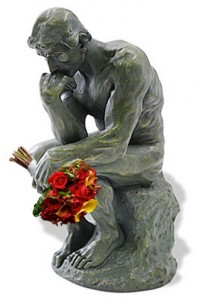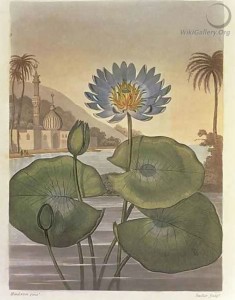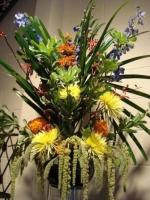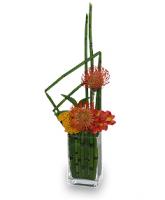 Preparing for the future is always easiest when we know from whence we came. In this month’s Aspects of Design from FlowerShopNetwork.com, we focus on popular periods of design and how they can be interpreted into floral designs. Below is a handy, easy-to-print chart with the style and time period in which the style of design was dominant. We also include a brief description of many styles.
Preparing for the future is always easiest when we know from whence we came. In this month’s Aspects of Design from FlowerShopNetwork.com, we focus on popular periods of design and how they can be interpreted into floral designs. Below is a handy, easy-to-print chart with the style and time period in which the style of design was dominant. We also include a brief description of many styles.
In floral design school? Need to brush up on your period pieces for a theme party? Interested in art behind what we do? Whatever your interest, the information below will help enhance your unique floral design skills.
Design Period |
Popularity Date Range |
| Egyptian Period | 2800-28 BC |
| Greek Period | 600-146 BC |
| Classical Period | 600-150 BC |
| Roman Period | 28 BC – 325 AD |
| Byzantine Period | 325-660 AD |
| Middle Ages | 476-1450 AD |
| Gothic Period | 1200-1425 AD |
| Persian Period | 1300-1700 AD |
| Renaissance Period | 1400-1600 AD |
| Flemish Period | 1550-1700 AD |
| Baroque Period | 1600-1700 AD |
| French Period | 1643-1715 AD |
| Rococo Period | 1715-1744 AD |
| Early American Period | 1620-1720 AD |
| Colonial Period | 1620-1780 AD |
| Georgian Period | 1714-1810 AD |
| English-Early Georgian Period | 1714-1758 AD |
| Classical Revival (Neoclassic Period) | 1762-1830 AD |
| England: Late Georgian Period | 1759-1810 AD |
| Regency Period | 1811-1830 AD |
| France: Louis XVI Period | 1774-1792 AD |
| Directoire Period | 1795-1799 AD |
| Empire Period | 1804-1814 AD |
| Germany: Biedermeyer Period | 1815-1848 AD |
| Russia: Period of Catherine The Great | 1762-1796 AD |
| America: Federal Period | 1789-1801 AD |
| Early Republic Period | 1801-1830 AD |
| Romantic Period | 1830-1890 AD |
| Victorian Period | 1830-1901 AD |
| Art Nouveau | 1880-1925 AD |
| Art Deco | 1925-1930 AD |
| Modern/Modernistic Period | 1930-1960 AD |

Blue Egyptian Water Lily
Egyptian Period Floral Design (2800-28 BC): Stylized, geometric shapes, especially the symmetrical triangle and fan, were common in this style of design. Interpret the Egyptian style into florals by concentrating on the 2 dimensional aspects of their highly-stylized, wall relief sculptures. Focus on flower color, instead of depth. Create ridged, geometric designs using gold and blue, which were very popular during this time. The blue Egyptian waterlily (Nymphaea coerulea) was a popular flower of the time.
Classic Period Floral Design (600-150 BC): This style of art reflects an appreciation for the Greek and Roman lifestyles. Symmetry and the idealization of the human body and its form are common characteristics of this style. Create wreaths and garlands of foliage to symbolize laurel wreaths worn by Olympians. Many classic sculptures portray the human figure in an slight, S-shaped curve, (or contrapposto) a possible inspiration when interpreting the Classical Period into floral design.
Byzantine Floral Design (325-660 AD): This style of design refers to the that of the Byzantine Empire of the early centuries AD. Lavish churches with golden domes, pointing spires and lots of gold mosaics were popular. Flower arrangements in this style might be arranged in a spiral or cone form. Use gold and jewel-toned flowers to help represent the colored tiles popular in Byzantine design.
Middle Ages Floral Design (476-1450 AD): This time in European history is also known as the Medieval Period or Dark Ages. During this time, monasteries cultivated a large part of the floral community, including garden herbs, fragrant flowers and medicinal plants. During this period, most of the flowers and herbs grown were for medicinal purposes. There is little emphasis on floral arranging for decorative purposes. However, fragrant flowers were used to freshen the air and for making garlands and wreaths.
Gothic Period Floral Design (1200-1425 AD): This style was popular during the late middle ages. Herb gardens and floral motifs used in ornate manuscripts were popular inside monasteries. The floral design in Gothic Period style features tall, arrangements that suggest dignity and repose. This design style is also characterized by a minimal amount of flowers, an early reference to their preciousness and unavailability at the time. Gothic architecture is characterized by it’s tall, very thin walls (many were made of glass) and very open space.
Persian Period Floral Design (1300-1700 AD): This style of design reflects the prevalence of flowers in Persian art. Persia is the origin of the tulip. Persian floral design is characterized by simple compositions in delicate flasks. Complementary hues are used and often feature warm, flame-like colors.
Renaissance Period Floral Design (1400-1600 AD): This style of design flourished after the Dark Ages in Europe, beginning in Italy in the 14th century. A revived interest in knowledge, beauty and classical art forms took hold. Floral arrangements of the time were massed in tight symmetrical shapes. Colorful flowers were used, often alongside fruits and vegetables. Containers during this period were typically urns, jugs and bowls. Flowers associated with virtues of the Christian religion, such as lily of the valley, were often used.
Flemish Period Floral Design (1550-1700 AD): Compatibility was overlooked in Flemish design. Many types and varieties of flowers, herbs and fruit were used together. Floral arrangements in the home were a sign of wealth, so often they would use exotic flowers paired with standard ones. These flower arrangements focused on rich colors, texture, and natural accessories (i.e. things found in nature such as birds nests). As these pieces focused on the flowers, containers were very simple and understated.
Baroque Floral Design (1600-1700 AD): This style of floral design, popular in Europe during the 1600’s, focuses on S-curve lines, embellished scrolls, and large amounts of ornamentation. Think above and beyond for this floral design style. Use large, dark flowers and house them in containers such as urns, tall vases or low baskets. Think of availability at the time; for ornaments choose fruit, jewelry, swirling shells and cherubs.
French Period Floral Design (1643-1715 AD): This style of floral design was also known as the “Grand Era” and included designs in 17th and 18th century France during the reign of Louis XVI. This design took many cues from the Dutch Flemish style, emphasizing classic form, refinement and elegance. Symmetry, opulence and extravagance, and ornamental vases were common features of French Period floral design.
Rococo Period Floral Design (1715-1744 AD): This style of design was popularized by the French during the reign of Louis XV. While many characteristics are similar in form to the Baroque period, Rococo style designs feature lighter, happier, more playful colors and forms. Floral arrangements in this style are typically designed in “S” curves and “C” scrolls. The playful femininity of youth was revered in this style. As a result, containers were made of delicate glass or hand-painted porcelain. Lots of whites and golds were used during this time.
Colonial Floral Design (1620-1780 AD): This was the style popular during the settlement of America, and is characterized by simple shapes, like squares and triangles. Colonial floral design uses unassuming bouquets consisting of easily gathered materials of that time. Garden flowers, herbs, grasses and branches can be placed in gourds or other natural containers. However, china and porcelain could also be used.
English-Early Georgian Period (1714-1758 AD): This style of design was most popular in early 18th century England. The flower designs, as a result of the formality of the time. Flowers were used more for the fragrance, than the aesthetics. Characteristics associated with this style are symmetry (usually triangular) and dignified opulence. These arrangements often featured flowers in only one color or only one type of flower. Containers were heavy at the beginning of this period but became lighter as the style faded.
Classical Revival Floral Design (1762-1830 AD): This style of art is also referred to as “Neoclassic Design.” More than 1,000 years after the popularity of the Classic Period of floral design, the discovery of the cities of Herculaneum and Pompeii created a revived interest in early Greco-Roman lifestyles, thus the style’s name. Symmetry and masculine, straight lines were once again popular. Create symmetrical designs or designs in cornucopias, and display upon pedestals or columns. Use foliage to create wreaths and garlands to represent laurel crowns worn by Olympians.
Federal Period (1789-1801 AD): This style was popular in post-Revolutionary War era America. Floral designs took their cues from ancient classical designs as well as large and symmetrical European bouquets. (See Classical Revival)
Victorian Period Floral Design (1830-1901 AD): Also known as the Romantic Period or Romantic Era, this period of design was named for the then-ruling Queen Victoria. Improved transportation led to the inclusion of a larger variety of plant materials. Use a mix of any type of flower, from tropical to garden. Flowers and plants were used to show opulence and beauty. Flowers were also used as fashion accessories, worn and carried. The rise of flower meanings took place during this period. Containers were decorative and ornate.
Art Nouveau Floral Design (1880-1925 AD): Asymmetry best characterizes this style of design and has been described as “sudden violent curves generated by the crack of a whip.” For Art Nouveau floral design, focus on rhythmic, flowing lines and whiplash curves. These flower arrangements are best suited in asymmetrical, curving containers.
Art Deco Floral Design (1925-1930 AD): The term “art deco” was derived from a 1925 exhibition in Paris, France, titled “Exposition Internationale des Arts Décoratifs et Industriels Modernes” or International Exposition of Modern Industrial and Decorative Arts. This style of design was most popular in the 1920’s and 1930’s, though then known as “modernistic.” For this style of floral design, focus on mathematical, geometric motifs and bold lines. This style heavily depends on the container, which geometric or linear patterns are key.
Modern/Modernistic Floral Design (1930-1960 AD): This style of floral design mirrors the architectural style focusing on simple, clean lines, minimal ornamentation, bright colors and industrial materials. This style was popular from the 1930’s to the 1960’s but was replaced in popular culture by Art Deco design.
This post was a collaboration of Mandy Maxwell and Brynn Jackson.
This post is brought to you by local Lexington, Kentucky florists.
Not in Lexington? No worries, Flower Shop Network connects you to your real local florist!


 Find Your
Find Your 







This is so interesting! I had no clue that floral design went back so far! I am considering going into floral design school, and I am leaning towards it even more now!